At all hours of the day, seven days a week, these scavengers prowl the alleys of Chicago looking for recyclable metals. The volatile price of scrap metal has been high for the last few years, which means these scrappers can make a lot of money if they can fit just a bit more junk on back of their trucks.
Anything made of metal left in the alley may turn up on the back of a scrapper truck: childrens bikes, office furniture, water heaters, filing cabinets, refridgerators, even parts of other cars. Just about anything that's not nailed down, even a few things that the owners didn't plan to get rid of.
 |
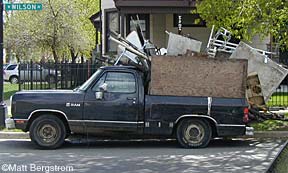 |
 |
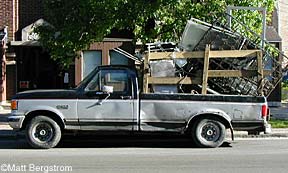 |
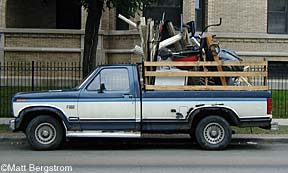 |
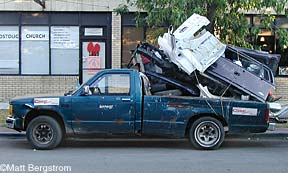 |
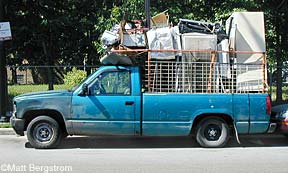 |
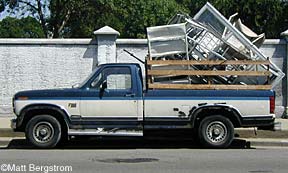 |
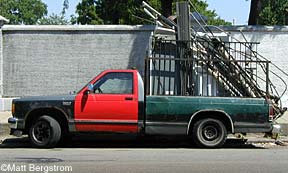 |
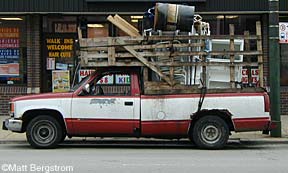 |
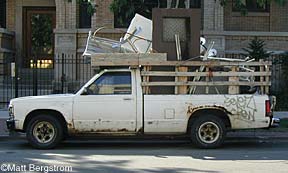 |
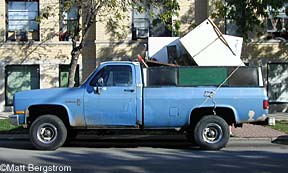 |
Early in the morning the scrappers haul their gathered materials to the salvage yards on Kingsbury Street or Ashland or other scrap dealers outside the city, where they are paid by the pound for various types of metal. Here they assemble in broken-down pickup trucks to await a turn at the scale where the scrap metal will be sorted by materials and placed in various dumpsters.
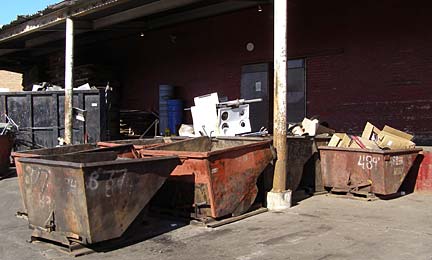
Most of the bicycles, folding chairs, refrigerators, bed frames and plumbing pipes, usable as they may be, are headed for the shredder. On east and west sides of the river near here you can watch enormous clawed cranes and electromagnetic dinosaurs sorting the metal by type and size, crushing and baling it, then loading it on barges. Although there are still several small steel mills in Chicago, such as nearby Finkl Steel, this unsorted scrap is bound for export overseas for use in construction or recycled into consumer items.
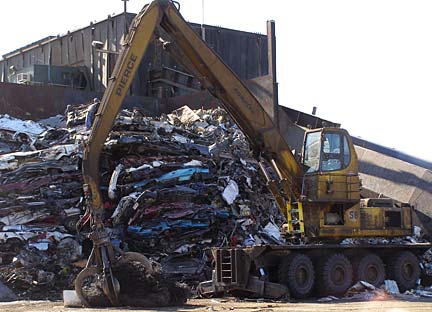
China and India are building new mega cities of glass and steel, and are hungry for metal. Worldwide the commodity prices of steel, copper and alumium are higher than they've been in years. Currently one-third of all construction cranes in the world are engaged in building skyscrapers in China. The raw materials come from all over the world, but currently scrap metal is the second-largest export from the US to China.
While Chicago and other rust-belt cities of the Midwest were built upon steel and the profits of the steel industry a hundred years ago, very little of that heavy industry remains here nowadays. Instead, piece by piece, household by household, the simple physical structure of Chicago is being broken down and shipped off to feed new exploding megacities such as Shenzhen, Shanghai, Chengdu, etc.
There are hundreds of scrappers living and working all over Chicago in less-gentrified neighborhoods, by day scouring every square inch of the city for all metal items, before the sun rises and late into the evening. The high price of scrap encourages them to pick up that last door knob or those extra plumbing pipes to make a few cents more. Across the city there are hundreds of these scrappers and they are a major force of domestic deindustrialization.
Each load of scrap metal hauled through the alley represents the end chapter of a story of the manufacture of common consumer items, many of them created right here in Chicago many years ago, now shipped off to lands on the other side of the world.

